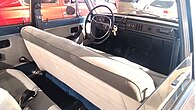
The V6 PRV engine is an automobile petrol V6 engine that was developed jointly by Peugeot, Renault and Volvo Cars – and sold from 1974 to 1998. It was gradually replaced after 1994 by another joint PSA-Renault design, known as the ES engine at PSA and the L engine at Renault. It was designed and manufactured by the company "Française de Mécanique" for PSA, Renault and Volvo.

The Saab 99 is a car which was produced by Saab from 1968 to 1984; their first foray into a larger class than the 96. While considered a large family car in Scandinavia, it was marketed as a niche compact executive car in most other markets. It was manufactured both in Sweden and Finland and was succeeded by the Saab 900, although the 99 continued to be produced alongside its successor. The Saab 90, an updated, less complex version using many 900 parts took over from the 99 in late 1984.

The Volvo 140 Series is a line of mid-size cars manufactured and marketed by Volvo from 1966 to 1974 in two- and four-door sedan as well as five door station wagon body styles—with numerous intermediate facelifts. More than a million Volvo 140s were built.

The Peugeot 504 is a mid-size, front-engine, rear-wheel-drive automobile manufactured and marketed by Peugeot from 1968 to 1983 over a single generation, primarily in four-door sedan and wagon configurations – but also as twin two-door coupé and cabriolet configurations as well as pickup truck variants.
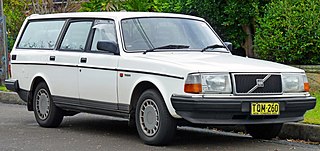
The Volvo 200 Series is a range of mid-size cars produced by Swedish company Volvo Cars from 1974 until 1993, with more than 2.8 million total units sold worldwide. Like the Volvo 140 Series, from which it was developed, it was designed by Jan Wilsgaard.

The BMW E12 is the first generation of 5 Series executive cars, which was produced from 1972 to 1981 and replaced the saloon models of the BMW New Class range.
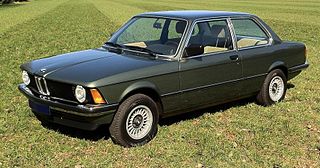
The BMW E21 is the first generation of the BMW 3 Series sporty compact executive cars, which were produced from June 1975 to December 1983 and replaced the BMW 02 Series. The series was exclusively built in a two-door coupé body style. Contrary to its predecessor, a 'Touring' body with a sloped rear hatch was no longer offered.

The Volkswagen Type 2 (T3) was the third generation of the Volkswagen Transporter and was marketed under various nameplates worldwide – including the Transporter or Caravelle in Europe, T25 in the UK, Microbus and Kombi in South Africa/Brazil/Australia, Kampeerauto in Netherlands, Combi in France and Vanagon in North and South America.

The Nissan S30, sold in Japan as the Nissan Fairlady Z and in other markets as the Datsun 240Z, then later as the 260Z and 280Z, is a grand tourer produced by Nissan from 1969 until 1978. The S30 was conceived of by Yutaka Katayama, the President of Nissan Motor Corporation U.S.A., and designed by a team led by Yoshihiko Matsuo, the head of Nissan's Sports Car Styling Studio. It is the first car in Nissan's Z series of sports cars.

The BMW New Six is a line of mid-size luxury sedans and grand tourer coupés produced by the German automaker BMW from 1968 to 1977. All models used the then-new M30 straight-6 engine. It marked BMW's return to the full-size luxury sedan market after a hiatus of 5 years and was introduced as a response to growing market segment dominated by Mercedes-Benz. It was important in establishing BMW's reputation as a maker of sporting luxury sedans.

The Volvo 440 and 460 are versions of a small family car produced by the Swedish manufacturer Volvo between June 1988 and September 1996. The 440 was a five-door hatchback and the 460 a four-door saloon which followed in 1989. They were built at the NedCar factory in Born, the Netherlands and were only offered with front-wheel drive.

The Opel Commodore is an executive car (E-segment) produced by Opel from 1967 to 1982. It is the six-cylinder variant of the Rekord with styling differences. The Commodore nameplate was used by Opel from 1967 to 1982. However, its nameplate/lineage continued until 2020 with the Australian Holden Commodore. The last generation was sold in the United Kingdom primarily as the Vauxhall Viceroy although Opel models were also sold.

The B18 is a 1.8 L inline four cylinder automobile engine produced by Volvo from 1961 through 1968. A larger 2.0 L derivative called the B20 debuted in 1969.

The Opel Manta is a rear-wheel-drive sports coupé built by German manufacturer Opel in two generations from 1970 to 1988. The Manta was a mildly sporting coupé based on the Ascona family car, competing with cars such as the Ford Capri. The Manta remained rear-wheel drive for both generations and also saw certain competition success. Its name comes from the manta ray.

The Volvo 700 series is a range of executive cars produced by the Swedish manufacturer Volvo Cars from 1982 to 1992. The 700 series was introduced in 1982 with the luxurious 760, followed two years later by the lower priced 740 which capitalized on the prestige attained by the very similar 760. The 700 series was then gradually replaced, beginning in 1990, by the 900 series. The 700, designed by Jan Wilsgaard, was originally to have been a replacement for the 200 series, but production of that model continued until the early nineties. The expensive 780, a Bertone-designed coupé version, entered production in 1986 and departed without a direct successor only four years later.
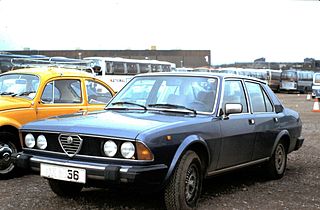
The Alfa Romeo Alfa 6 is an executive car produced by the Italian company Alfa Romeo from 1979 to 1986. Its name refers to the six cylinders of the Alfa Romeo V6 engine, which made its first appearance on this car.

The General Motors H platform is an automobile platform used by subcompact cars from the 1971 to 1980 model years. The first subcompact car design developed by GM, the rear-wheel drive H platform initially underpinned the Chevrolet Vega and its Pontiac Astre counterpart. For 1975, the H platform was expanded from entry-level vehicles to sport compacts, adding the Chevrolet Monza, Buick Skyhawk, Oldsmobile Starfire, and Pontiac Sunbird.

The B30 is an inline-six automotive petrol engine produced by Volvo starting in 1968. It was used primarily in the Volvo 164 sedan from 1969 through 1975. The engine also appeared in military, marine, industrial, agricultural, and powercraft applications.
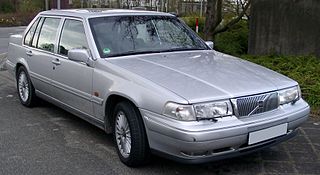
The Volvo 900 Series is a range of executive cars produced by the Swedish manufacturer Volvo Cars from 1990 to 1998. The 900 Series was introduced in 1990 to replace the 700 Series from which it derived. Prior to the end of its production, the 960 was renamed as the Volvo S90 (saloon) and Volvo V90 (estate), and the 940 was renamed 940 Classic, becoming the last rear-wheel-drive cars from Volvo, until the 2023 Volvo XC40.
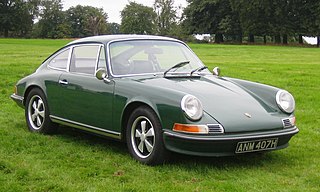
The original Porsche 911 is a luxury sports car made by Porsche AG of Stuttgart, Germany. A prototype of the famous, distinctive, and durable design was shown to the public in autumn 1963. Production began in September 1964 and continued through 1989. It was succeeded by a modified version, internally referred to as Porsche 964 but still sold as Porsche 911, as are current models.








